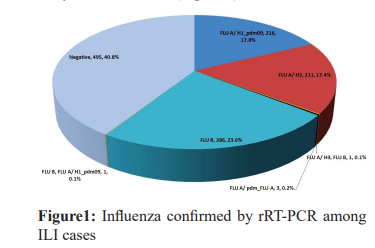Abstract
Introduction: Several viruses can cause clinical
features similar to influenza. The term ‘influenzalike illness’ is used to describe the clinical features
that can be attributed to infection caused by
influenza and other respiratory viruses. Influenza
infection can result in mild to serious illness,with
significant mortality rates worldwide. Pokhara
Academy of Health Sciences, Western Regional
Hospital, Pokhara is one of the sentinel sites for
human surveillance of influenza in Nepal that is
maintained by Walter Reed/ AFRIMS Research Unit
Nepal (WARUN). The objective of this study is to
analyze demographic and laboratory parameters of
cases of influenza like illness.
Materials and Methods: A retrospective study
was conducted from July 1st 2018– December 31st
2019 at Pokhara Academy of Health Sciences,
Pokhara. Approval for research was obtained from
National Health Research Council, Kathmandu.
Demographic features were noted, temperature
was measured in each case and reports of influenza
tests were recorded. Results: 1213 subjects were
enrolled during study period and 63% were males.
Most patients were in age group <15 years (82.5%)
followed by age group of 16 to 45 years (14.7%).
Average axillary temperature was similar among
both influenza positive and negative population.
Majority (59.2%) tested positive for influenza virus,
of which the most frequent was influenza A (59.9%).
Conclusion: Influenza stands as an important public
health threat. Surveillance of influenza helps in
early warning system, to understand local outbreaks
and to prepare for global pandemics. A larger study
spanning over several years would have been more
informative.
References
associates with influenza epidemics. Epidemio
Rev. 1982;4:25-44.
2. Gross PA. Preparing for the next influenza
pandemic: a reemerging infection. Ann Internal
Med. 1996; 124(7): 682-85.3.
3. World health organisation [Internet]. WHO
surveillance case definitions for ILI and SARI.
Available from https://www.who.int/influenza/
surveillance_monitoring/ili_sari_surveillance_
case_definition/en/
4. Kelly H, Birch c. The causes and diagnosis
of influenza-like illness. Australian Family
Physician. 2004 May; 33(5): 305-9.
5. Sharon G H, Thuylinh N. P. Influenza-Like
Illness Diagnosis and Management in the Acute
Care Setting. Pediatr Emer Care. 2016;32: 875–
84.
6. Park, A. W., & Glass, K. (2007). Dynamic
patterns of avian and human influenza in east
and southeast Asia. The Lancet infectious
diseases, 7(8), 543-548.
7. Daum LT, Canas LC, Klimov AI, Shaw
MW, Gibbons RV, Shrestha SK, Myint KS,
Acharya RP, Rimal N, Reese F, Niemeyer
D, Arulanandam B, Chambers JP. Molecular
analysis of isolates from influenza B outbreaks
in the U.S. and Nepal, 2005. Archives of
Virology 2006;151:1863-74.
8. Daum LT, Shaw MW, Klimov AI, Canas LC,
Macias EA, Niemeyer D, Chamber JP, Renthal
R, Shrestha SK, Acharya RP, Huzdar SP, Rimal
N, Myint KS, Gould P. Influenza A (H3N2)
outbreak, Nepal. Emerg Infect Dis 2005 Aug;
11(8):1186-91.
9. Shinde V, Hanshaoworakul W, Simmerman JM,
Narueponjirakul U, Sanasuttipun W, Kaewchapa
S, Areechokechai D, Ungchusak K, Fry AM, A
Comparision of Clinical and Epidemiological
Characteristics of Fatal Human Infections with
Influenza Like Illness: 18 months Surveillance at Pokhara Academy of Health Sciences. Banstola L et. al.
~327~˷
Original Article Medical Journal of Pokhara Academy of Health Sciences Vol. 4 Issue 1
H5N1 and Human Influenza Viruses in Thailand,
2004-2006, PLoS One 2011; 6(4): el4809.
10. Boyle JR. Sparks RS, Keijzer GB, Crilly JL,
Lind JF, Ryan LM. Prediction and surveillance
of influenza epidemics. Med J Aust. 2011;
194(4):828-33.
11. Khuwaja S, Mgbere O, Awosika-Olumo A,
Momin F, Ngo K. Using Sentinel Surveillance
System to Monitor Seasonal and Novel H1N1
Influenza Infection in Houston, Texas; Outcome
Analysis of 2008-2009 Flu Season. J Community
Health 2011.
12. Brammer L., Blanton L, Epperson S, Mustaquim
D, Bishop A, Kniss K, Shara R, Nowell M.,
Kamimoto L, Finelli L. Surveillance for
influenza during the 2009 influenza A (H1N1)
pandemic-United States, April 2009-March
2010, Clin Infec Dis, 2011; 52 Suppl 1:S27
13. Yang JH et al. Predictive Symptoms and Signs of
Laboratory-confirmed Influenza: A Prospective
Surveillance Study of Two Metropolitan Areas
in Taiwan. Medicine(Baltimore). 2015 Nov;
94(44): e1952.
14. Navarro-Mari JM, Pérez-Ruiz M, CantudoMuñoz P, Petit-Gancedo C, Jiménez-Valera M,
Rosa-Fraile M. -like illness criteria were poorly
related to laboratory-confirmed influenza in a
sentinel surveillance study. Journal of Clinical
Epidemiology. 2005 Mar;58(3):275-79.
15. Adisasmito W, Budayanti S, Aisyah DN, Coker
R, Andayan AR, Smith GJD, Rudge JW.
Surveillance and characterisation of influenza
viruses among patients with influenza-like
illness in Bali, Indonesia, July 2010–June 2014.
BMC Infect Dis. 2019;19:231.
16. Nisar N et al. Epidemiology of Influenza among
patients with influenza‐like illness and severe
acute respiratory illness in Pakistan: A 10‐year
surveillance study 2008‐17. Journal of Medical
Virology. 2020 Apr.

